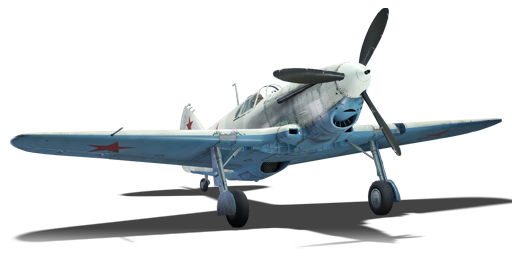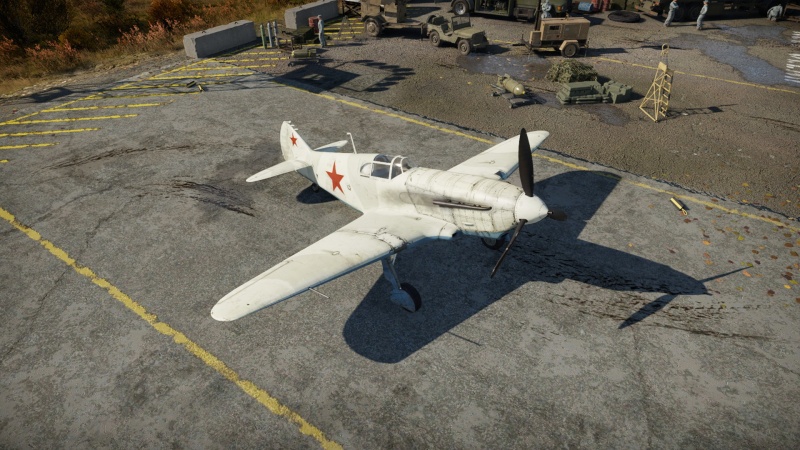Difference between revisions of "LaGG-3-8"
(Updated format) |
m (→External links) |
||
| Line 239: | Line 239: | ||
== External links == | == External links == | ||
| − | ''Paste links to sources and external resources, such as:'' | + | <!--''Paste links to sources and external resources, such as:'' |
* ''topic on the official game forum;'' | * ''topic on the official game forum;'' | ||
* ''encyclopedia page on the aircraft;'' | * ''encyclopedia page on the aircraft;'' | ||
| − | * ''other literature.'' | + | * ''other literature.''--> |
| + | * [https://forum.warthunder.com/index.php?/topic/195728-lavochkin-gorbunov-gudkov-lagg-3-series-8/ Official data sheet - more details about the performance] | ||
{{AirManufacturer Lavochkin}} | {{AirManufacturer Lavochkin}} | ||
{{USSR fighters}} | {{USSR fighters}} | ||
Revision as of 11:58, 24 January 2021
| This page is about the Russian fighter LaGG-3-8. For other versions, see LaGG-3 (Family). |
Contents
Description
The LaGG-3-8 is a rank II Russian fighter with a battle rating of 2.3 (AB) and 2.0 (RB/SB). It was introduced in Update 1.33.
The LaGG-3-8 is one of the first aircraft in the game to be armed with a cannon. It is also one of three Soviet fighters in rank II to be armed with a cannon, the others being the LaGG-3-11 and Yak-1. As the first monoplane fighter for many rank I Soviet pilots, a big change from the reserve biplanes, it is an introduction to a whole new range of tactics and armaments.
General info
Flight performance
Describe how the aircraft behaves in the air. Speed, manoeuvrability, acceleration and allowable loads - these are the most important characteristics of the vehicle.
The LaGG-3-8 has decent responsiveness. It climbs fairly well, and gets to speed quickly. Roll rate is good, and it doesn't compress much. However, the turning circle is subpar to Yak counterparts.
| Characteristics | |||||||
|---|---|---|---|---|---|---|---|
| Stock | |||||||
| Max Speed (km/h at 5,000 m) |
Max altitude (meters) |
Turn time (seconds) |
Rate of climb (meters/second) |
Take-off run (meters) | |||
| AB | RB | AB | RB | AB | RB | ||
| 532 | 514 | 9000 | 25.3 | 26.3 | 7.6 | 7.6 | 400 |
| Upgraded | |||||||
| Max Speed (km/h at 5,000 m) |
Max altitude (meters) |
Turn time (seconds) |
Rate of climb (meters/second) |
Take-off run (meters) | |||
| AB | RB | AB | RB | AB | RB | ||
| 578 | 554 | 9000 | 22.8 | 24.0 | 14 | 10.5 | 400 |
Details
| Features | ||||
|---|---|---|---|---|
| Combat flaps | Take-off flaps | Landing flaps | Air brakes | Arrestor gear |
| ✓ | ✓ | ✓ | X | X |
| Limits | ||||
|---|---|---|---|---|
| Wing-break speed (km/h) |
Gear limit (km/h) |
Combat flaps (km/h) |
Max Static G | |
| + | - | |||
| 0 | 350 | 460 | ~11 | ~8 |
| Optimal velocities | |||
|---|---|---|---|
| Ailerons (km/h) |
Rudder (km/h) |
Elevators (km/h) |
Radiator (km/h) |
| < 380 | < 380 | < 380 | > 323 |
| Compressor (RB/SB) | ||
|---|---|---|
| Setting 1 | ||
| Optimal altitude | 100% Engine power | WEP Engine power |
| 2,000 m | 1,100 hp | 1,232 hp |
| Setting 2 | ||
| Optimal altitude | 100% Engine power | WEP Engine power |
| 4,000 m | 1,050 hp | N/A |
Survivability and armour
- 8 mm Steel plate behind the pilot.
Modifications and economy
Armaments
Offensive armament
The LaGG-3-8 is armed with:
- 1 x 20 mm ShVAK cannon, nose-mounted (150 rpg)
- 1 x 12.7 mm Berezin UB machine gun, nose-mounted (200 rpg)
Usage in battles
The LaGG-3-8 should be flown mainly as a fighter. It can be used as a bomber hunter, but it is not well suited to this role due to its average rate of climb and fragile engine.
Due to the average rate of climb, this aircraft is best used in diving attacks, booming and zooming in and out of the fray.
If up against a fighter or single engine aircraft, aim for the main mass of the plane, the fuselage. If up against a heavy fighter or bomber, aim for a single engine or wing. Usually a burst of cannon fire into these areas will do them in. If you happen to come up against an aircraft with similar armament (central cannons), take a few pot shots, roll and dive out of the fight to a safe distance. However, against most other planes, the nose mounted armament of the LaGG-3-8 excels. Another thing to watch out for is the plane's fragile engine, as it can be easily knocked out by aircraft with heavier armament.
At this low rank, there are many planes that can out-turn the LaGG-3-8. Although this aircraft can pull a very fast initial turn, in a sustained turn-fight it will start to show its faults. Its weak engine combined with a heavy airframe means that this aircraft bleeds energy very quickly in tight turns, nosing down during long, low speed turns. Once at this state of low energy, its average climb rate and acceleration worsens, posing it as an easy target for even the slowest of fighters.
In summary, the main points to take note of when flying this aircraft are:
- Keep your speed and energy up
- Use your dive speed and nose mounted cannon to your advantage
- Go for unsuspecting targets when alone or in furballs
- Don't engage in a sustained turn fight
- Try not to get the engine damaged
Manual Engine Control
| MEC elements | ||||||
|---|---|---|---|---|---|---|
| Mixer | Pitch | Radiator | Supercharger | Turbocharger | ||
| Oil | Water | Type | ||||
| Controllable | Controllable Not auto controlled |
Controllable Auto control available |
Controllable Auto control available |
Separate | Controllable 2 gears |
Not controllable |
Pros and cons
Pros:
- Relatively fast for its battle rating
- Good diving speeds
- Average turn time
- Fairly good roll rate
- Armament centred in nose
- Easy to fly
Cons:
- Rate of climb is average at best due to weight and weak engine
- Can be out-turned easily by biplanes
- to nose down in sustained low speed turns
- Low ammunition capacity & damage potential
- Cannon and machine gun rounds follow different trajectories
- Engine overheats and can be knocked out quite easily (liquid-cooled)
History
The LaGG-3 was designed by Soviet engineers Lavochkin, Gorbunov, and Gudkov to replace the LaGG-1. The original LaGG-3 prototype was made almost entirely out of wood. The airframe was made out of special multi-ply wood bonded with resin. The wings were similar to that of the Yak-1, the difference being the LaGG wing was made in two sections. The fuselage was similar to another Russian fighter, the MiG-3. Armament includes a 20 mm ShVAK rapid-fire cannon with 150 RPG mounted in a hollow shaft. A 12.7 mm Berezin machine gun was synchronized and mounted on the engine cowling with 170 RPG. The LaGG-3 had many problems during production, the Klimov M-106 engine was powerful but unreliable. The Klimov M105, however, was more reliable but weaker. This led to the LaGG-3 being severely underpowered and disliked by many pilots. This led to Lavochkin's decision to install a more powerful Shvetsov M-82 radial. Which gave birth to one of the most feared fighters in the game: the La-5.
In-game description
The breakneck rush to produce fighters in 1941, in tandem with an influx of unqualified personnel to aircraft plants, led to an unavoidable drop in quality in the assembly and machining of planes. The situation was worsened by an emerging shortage of Bakelite plywood, which had to be replaced with standard pine and birch. As a result, the LaGG-3's weight increased again, and its aerodynamic properties and flight characteristics decreased.
Designers attempted to counteract the increased weight by weakening its weaponry yet again. The LaGG-3 Series 8 had its synchronized 7.62 mm ShKAS machine guns removed.
The plane's armament now consisted of a 20 mm Shpitalny-Vladimirov ShVAK cannon in the cavity between the engine cylinders with 150 shells, and a 12.7 mm synchronized Berezina BS installed in the nose section of the fuselage above the engine and to the right with 200 rounds each.
This airborne armament configuration became standard, and remained unchanged (except for series 34 planes) until LaGG-3 series production ceased.
Externally, the LaGG-3 Series 8 planes differed in the absence of the now unnecessary ShVAK cannon fairings on the engine hood.
The LaGG-3 Series 8 went into production at the end of 1941. LaGG-3 fighters of this model were produced right up until series 11 was launched.
Consequently, in less than a year, the LaGG-3 went from being a plane with excellent firepower to a fighter with a relatively average armament. Unfortunately, its "disarmament" only slightly improved its flight characteristics. The LaGG-3 still weighed nearly 300 kg more than the Yak-1, which was superior in speed, maneuverability and ascension rate. But worse still, it was not only inferior to its fellow Soviet Yak, but also to the German Messerschmitt, particularly its new Bf.109F model.
Nonetheless, in spite of its drawbacks, the LaGG-3 was actively used on the front starting in August 1941. In the autumn of 1941, it was used on the Bryansk, Kalinin and Western fronts and in the Moscow Air Defense Force.
Media
Excellent additions to the article would be video guides, screenshots from the game, and photos.
See also
External links
| Lavochkin Design Bureau (Лавочкинa Опытное конструкторское бюро) | |
|---|---|
| LaGG-3* | I-301 · LaGG-3-4 · LaGG-3-8 · LaGG-3-11 · LaGG-3-23 · LaGG-3-34 · LaGG-3-35 · LaGG-3-66 |
| La-5/7 | La-5 · La-5F · La-5FN · La-7 · Dolgushin's La-7 · La-7B-20 |
| La-9/11 | La-9 · La-11 |
| Jet Fighters | La-15 · La-174 · La-200 |
| Export | ␗La-9 · ␗La-11 |
| Captured | ▀La-5FN |
| *Lavochkin-Gorbunov-Gudkov (Лавочкин-Горбунов-Гудков), head designer V. P. Gorbunov | |
| USSR fighters | |
|---|---|
| I-15 | I-15 WR · I-15 M-22 · I-15 M-25 · I-15bis · Krasnolutsky's I-15bis |
| I-153 M-62 · Zhukovsky's I-153-M62 · I-153P | |
| I-16 | I-16 type 5 · I-16 type 10 · I-16 type 18 · I-16 type 24 · I-16 type 27 · I-16 type 28 · I-180S |
| I-29 | I-29 |
| I-185 | I-185 (M-71) · I-185 (M-82) |
| I-225 | I-225 |
| ITP | ITP (M-1) |
| MiG-3 | MiG-3-15 · MiG-3-15 (BK) · MiG-3-34 |
| LaGG | I-301 · LaGG-3-4 · LaGG-3-8 · LaGG-3-11 · LaGG-3-23 · LaGG-3-34 · LaGG-3-35 · LaGG-3-66 |
| La | La-5 · La-5F · La-5FN · La-7 · Dolgushin's La-7 · La-7B-20 · La-9 · La-11 |
| Yak-1/7 | Yak-1 · Yak-1B · Yak-7B |
| Yak-3 | Yak-3 · Eremin's Yak-3(e) · Yak-3P · Yak-3T · Yak-3U · Yak-3 (VK-107) |
| Yak-9 | Yak-9 · Yak-9B · Golovachev's Yak-9M · Yak-9T · Yak-9K · Yak-9U · Yak-9UT · Yak-9P |
| Other countries | ▂P-40E-1 · ▂P-47D-27 · ▂Hurricane Mk IIB · ▂Fw 190 D-9 · ▂Spitfire Mk IXc |
| P-39 | ▂P-39K-1 · ▂Pokryshkin's P-39N-0 · ▂P-39Q-15 |
| P-63 | ▂P-63A-5 · ▂P-63A-10 · ▂P-63C-5 |





